BMES Provides Biomedical Engineering Resources to Students of All Ages
November 14, 2018
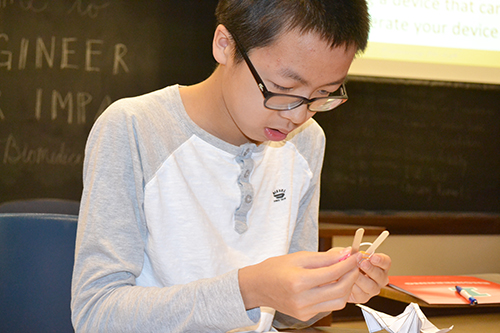
A Bioengineer Your Impact participant works to create a prosthetic device that will pick up a variety of objects during the event's design challenge.
One of the main goals of Illinois’ Biomedical Engineering Society (BMES) is to shape well-rounded Bioengineering (BioE) students by providing a variety of resources and opportunities for its members. However, almost as important to BMES members is their desire to maintain the BioE pipeline by interesting high school students (and even younger ones) in going into the field—possibly at Illinois. This was the goal of one of their major outreach events of the year—Bioengineer Your Impact—which recently took place on Saturday, November 10th.
The 13 high schoolers who showed up on campus for the event discovered what Bioengineering is about through a variety of different activities and interactions. For instance, they discovered some of the careers available in the field during presentations featuring two BioE start-up companies by current or past Illinois students: Psyonic, which makes prosthetic devices for amputees, and PhantomCor, a company comprised of current Illinois engineering students that designs synthetic organ models for surgical students to practice with.

BMES' Bioengineering Your Impact chair, Bianca Savant, picks up a marshmallow with the device she created for the design activity.
Participants also learned what being a student at Illinois might be like as they interacted with a panel of BioE students and toured two campus buildings: Everitt Lab, the new home of BioE, and IGB, the Institute of Genomic Biology. Plus, they learned a bit more about what Bioengineers can do while being exposed to some of the projects BMES students have created for EOH (Engineering Open House), such as a prosthetic hand, learned about hydrogels (the future of drug delivery?), and made DNA origami.
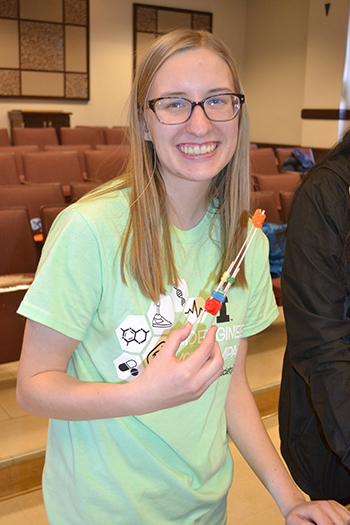
Stephanie Slowick, a BMES member in charge of the Design Activity, shows off the device she created as an example.
In one of the key events of the day, participants then got to try creating devices themselves during the design activity. Students were challenged to create a device that would pick up a number of different different-shaped objects: beads, marshmallows, tacks, and dice. Their apparatus was to not only pick up the objects individually, but possibly have different adaptions to pick up the various objects. Students were also encouraged to try to pick up several objects at a time, and also using just one hand.
While outreach is considered to be important, BMES' main function is to provide resources for its 200+ members, most of whom are BioE majors. However, students from other majors who are interested in what BMES does also join the group; other engineering students as well as non-engineering students, such as from Biology and Chemistry.
So, to provide activities that help shape well-rounded students, BMES committees provide professional, technical, social, media, and outreach activities and resources.
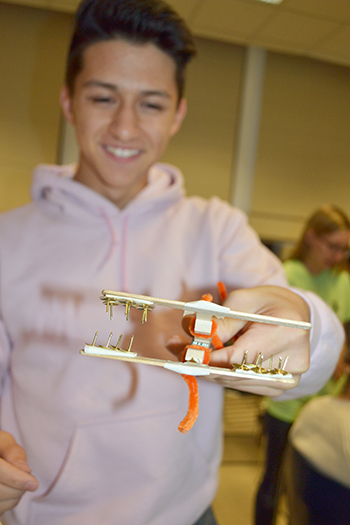
A high schooler shows off the device he and hs teammate created.

An Illinois BioE student exhibits the prosthetic device her EOH team designed. In fact, she is an intern at Psyonic, and prosthetics might be her future career.
For instance, one important opportunity BMES' Professional Committee provides members is professional development. In fact, some of its most popular events are its general meetings (GMs), which occur once or twice a month and feature speakers from BioE companies like Ad V, Abbot, Baxter, and Medline, who talk about their companies, network with students about interning, then collect resumes. BMES Outreach Coordinator Joy Chen calls it "better than a career fair, because there are fewer people, and it's more one-on-one.”
In fact, at one recent GM, a professor talked about alternative careers in BioE. According to Chen, BioE students aren’t always sure what they’re going to do with their degree because there are so many options. So the talk helped students narrow down what they can do with their degree, what their options are, and how to go about doing them.
In addition to GMs, the Professional Committee also schedules professional development workshops targeting specific topics. For instance, one recent workshop taught participants about coding systems, like MatLab, which many freshmen found helpful since Bio E classes use it. The committee also holds grad school and/or med school prep workshops, such as how to do initial and second interviews.
The Technical Committee is in charge of BMES’ technical teams. For example, participating in EOH is a key emphasis for BMES members, to both communicate to the public about BioE, as well as expose youngsters to BioE and possibly get some interested at an early age. Every year, BMES fields around 20 teams which complete short-term projects which they then present during EOH. “We love it and take it really seriously,” admits Chen.
Another resource under technical is BMES’ design teams, which are similar to EOH projects, but more long-term. Grouped in the 2–3 teams, participants work with faculty members on real-world projects.
Lest all work and no play make Jack (and Jill) dull, BMES’ Social Committee also schedules numerous extracurricular events, such as picnics and study sessions, which Chen calls, “just fun stuff to relax.”
One key aspect of the social activities is BMES’ mentor program. Upperclassmen, even some sophomores, sign up to mentor freshmen interested in being mentored. Every year, there’s a different theme; in 2018 it’s Harry Potter. In fact, just like at Hogwarts, BMES recently held a sorting ceremony, during which they put a BioE hat on each freshman and sorted them into their respective houses.
A sophomore, Chen signed up to be a mentor this year, because as a freshman, she had a one—two actually: Elizabeth, who's the BMES president, and Cassie, who graduated last spring. She reports that both mentors were really involved in BMES, “and they taught me a lot about what BMES stands for and what you can do through BMES. I felt that making that connection through them was really helpful for me.”
Although she’s no longer being officially mentored, she still seeks out tips from upperclassmen—especially advice regarding: “what classes to take, and what to expect in my upcoming years, and how to prepare for BioE, because it's pretty scary. It's a big field. It's really helpful to have connections with upperclassmen.”
Another BMES’ committee, the Media Committee, advertises the organization’s events, including via social media, and takes pictures.
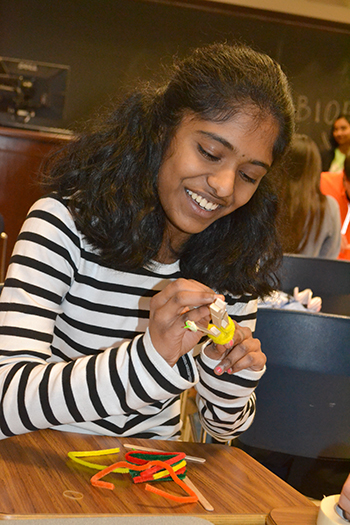
A student at Bioengineer Your Impact enjoys creating her team's device during the design challenge.
Last but not least, and a big part of BMES, is its Outreach Committee, which plans events that communicate what Bioengineering is to the community, especially youngsters and, of course, high school students. In fact, it was because of the influence BMES had on her as a high schooler that Chen joined the outreach committee. “Outreach is a big part of what got me into engineering, especially BioE,” she says. “So I wanted to be a part of that and see if I could inspire kids as well.”
Chen knows from personal experience how important campus exposure can be for high schoolers. She’s known about BMES since she was in high school because she attended Illinois’ University Laboratory High School located right across the street from the Digital Computing Lab (DCL), the former home of Bioengineering. When she would come to EOH every year, her first stop was always DCL, where she’d go through the building and see all the cool projects.
‘I'd walk in the building,” she says, “and there'd be a big BMES sign. And I always wanted to study Bio Engineering, so I'd walk up and say, ‘I'm interested in your club. I'm not a freshman here yet, but I really hope to be here in a couple of years!’”
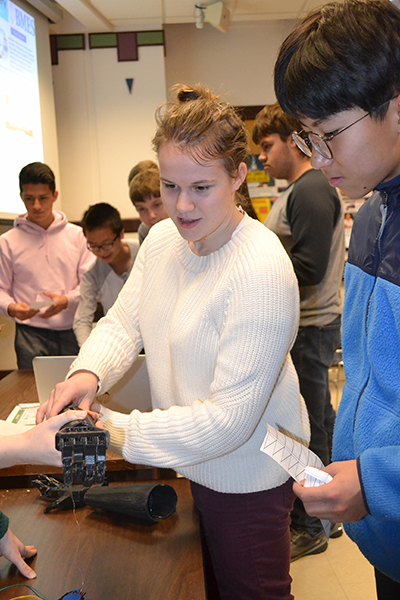
Bioengineer Your Impact participants examine a prosthetic device BMES students created for EOH.
Chen admits that she’s wanted to join BMES ever since she was in high school. So when she got to Illinois as a freshman, she went to their first GM, which she recalls featured, Psyonic, begun by a former Illinois grad student and undergrad. “So I went to that, she admits, “and I thought it was really cool. I joined my freshman year.”
In addition to the day-long Bioengineering Your Impact outreach, the Outreach Committee also arranges more regular, monthly outreach events at local schools. For instance, this year they’re going to be visiting St. Matt's Elementary and Central High School, plus Hayworth Elementary, which is a couple of hours away. Some hands-on activities they do include a heart pump activity to teach middle school kids about different parts of the heart, or for younger kids, a strawberry DNA activity, or teaching kids about how a cell works using bubbles. Chen says these simpler activities, “get kids interested and asking a lot of questions.”
Chen is excited about getting more members involved in school outreach this year. She says that last year, some members had a hard time participating because the schools wanted BMES volunteers to come during the day, when many had classes. However, this year many members have breaks in the middle of the day so Chen is hopeful that many will be able to participate in school outreach.
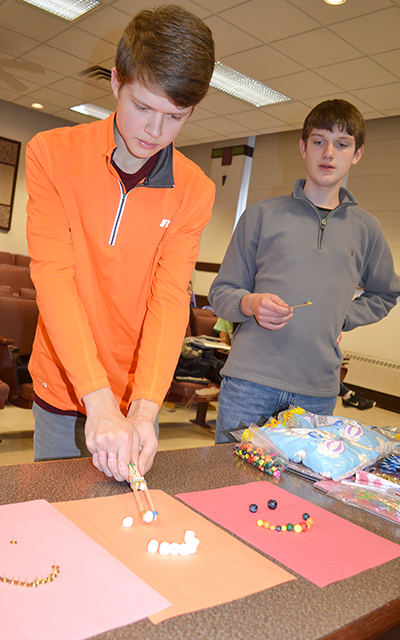
High school students test their device by picking up marshmallows.
Chen also has big plans for expanding her committee’s reach. “I really hope to grow outreach even more this year, and get more involved in events,” she admits. For instance, she and her team hope to do events on the weekends that parents can bring their kids to, like a big event at the library where kids can rotate through a number of stations doing different BioE-related activities. Plus, last year, Outreach did events with the Orpheum Children's Science Museum, which they hope to repeat again this year.
Besides volunteering with kids, though, Outreach also hopes to get members more involved in community service activities, such as helping around campus, cleaning Green Street, etc. To further encourage community service, Chen, who is the BMES liaison on the Society of Women Engineer's community service committee, hopes to get more people at BMES events by scheduling joint activities involving both SWE and BMES members.
Another new type of outreach activity Chen hopes to begin is a shadowing program that will give high school students exposure to research. “Not everyone can get lab experience in high school,” Chen acknowledges, so she hopes to convince BioE upperclassmen to take high schoolers under their wings, so students can experience a lab setting in a Research I university and see how everything works.
“I went to school here, so I had the whole campus,” Chen admits. At a high school on a university campus, she had a lot of opportunities to work in a lab, and took them. “I felt like they were really helpful for me understanding how a lab works. It's very different from what you might think. The skills you learn in a lab are very different from the skills you learn in school. Performing experiments takes a different skill set. I think those are very valuable things to learn as early as possible.”
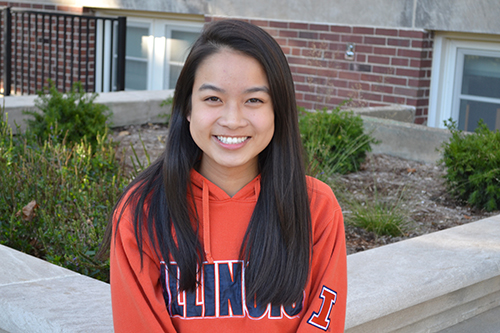
BMES Outreach Chair, Joy Chen.
In fact, for Chen, those experiences have pretty much shaped her career choices. Most of her lab experience was in Molecular and Cellular biology, which is the research she’s interested in. While she’s considered continuing in that, she also believes engineering is important in order to find solutions to these problems and apply research to the real world. “That was so important to me, and I definitely wanted to continue doing this, but also incorporate it in engineering,” says Chen.
In fact, that’s her dream job—to get an Md PhD and do research. She’s been in a research lab doing cancer research for a couple years now, studying the effects of cholesterol on cancer metastasis (the spread of cancer cells from where the cancer started into new areas of the body.
“So I think doing research and furthering the research field is very interesting; there's always something new to discover, and I always want a part of myself to be doing that. But I also think applications, being able to apply what you learn in that research lab to a hospital clinical setting and taking it to real people, which is the medicine side of it.”
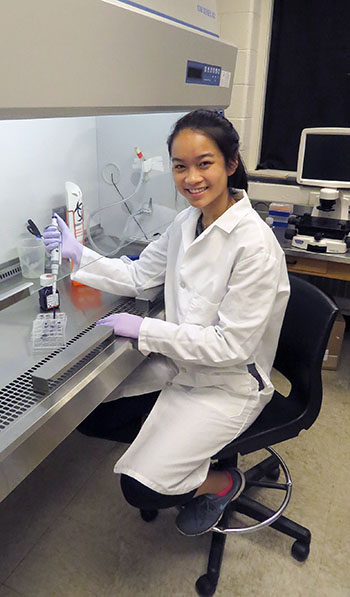
Joy Chen at work in Professor Erik Nelson's lab (photo courtesy of Ashley Lawrence).
Would she go to the new Carle Illinois School of Medicine? “That's the dream!” she acknowledges. “It's very engineering based. And it's right here.”
For additional I-STEM web articles related to Biomedical Engineering and Bioengineering, see:
- BMES Outreach Exposes High School Students to Career Possibilities in Bioengineering
- Bioengineering Undergrads Build Biobots in New BIOE 306 Course
- Two Illinois Students to Make Low-Cost Bionic Prosthetics More Accessible
- BIOE Students Shine in Senior Design
Story and photos by Elizabeth Innes, Communications Specialist, I-STEM Education Initiative
More: 8-12 Outreach, BioE, 2018
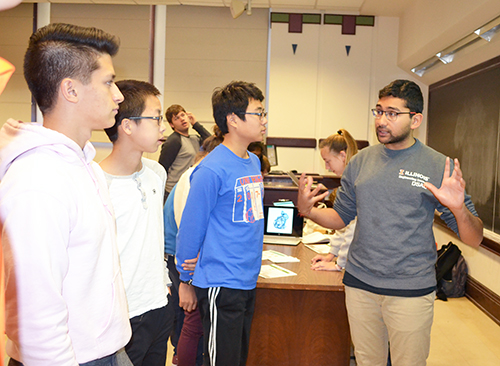
BMES Techical Director, Viraat Goel, explains his team's EOH project about hydrogels (the future of drug delivery) to several high school students.
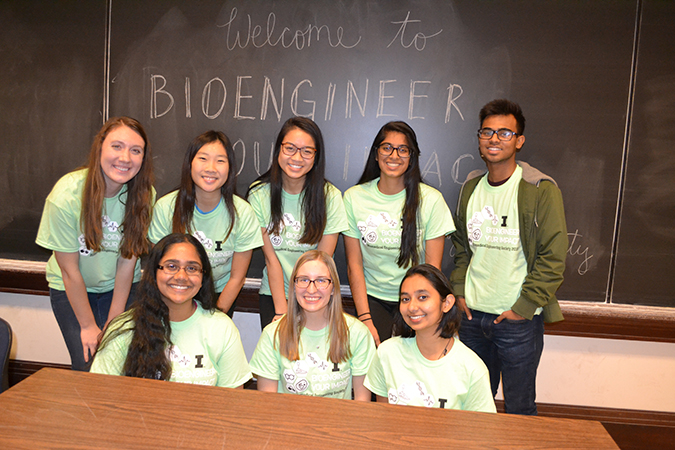
BMES members who helped out at Bioengineer Your Impact.













.jpg)
















